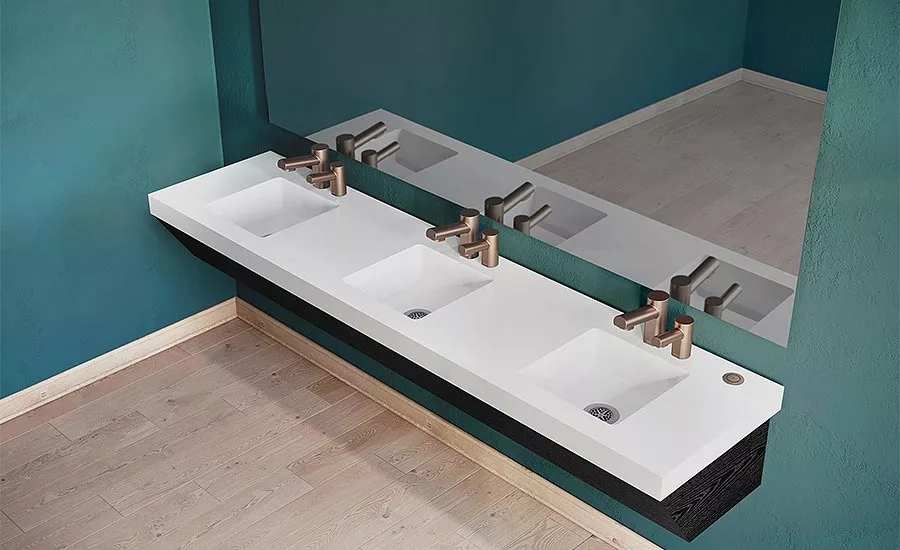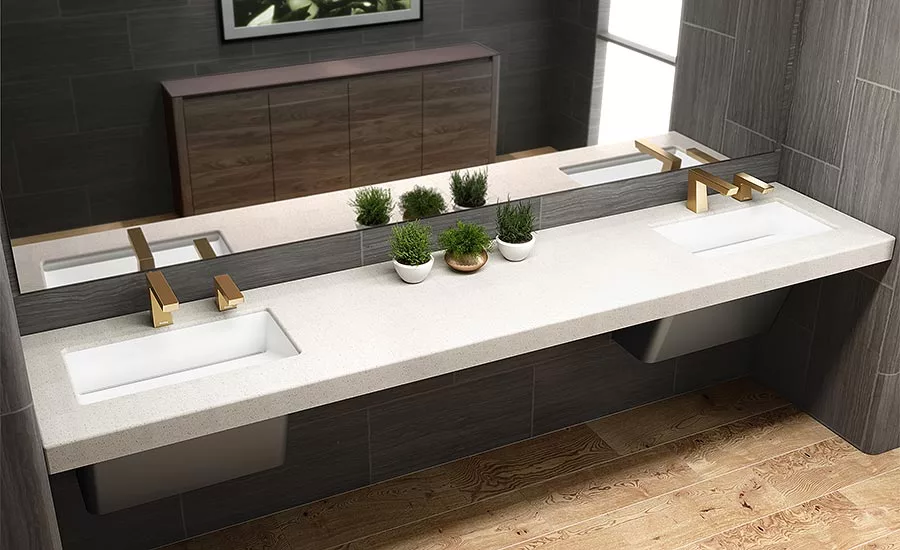Post-pandemic commercial restroom design trends
Hygiene is the new gold standard in restrooms.

Today’s advanced touchless technology provides a smooth and reliable handwashing experience. Optimized sensing eliminates false activations while enhancing accuracy and power consumption.

All-in-one handwashing designs eliminate the need for people to move away from the sink in search of a paper towel, hand dryer or waste basket with dripping-wet hands, which eliminates the risk of slips and falls and the need for extra maintenance.

New washbasin designs with increased space between the hand washing areas allow for social distancing while washing hands.
Covid-19 has made a permanent mark on the perception, functionality and design of commercial restrooms. Just as 9/11 changed air travel and the iPod transformed how we listen to music, the coronavirus pandemic will forever change public bathroom design and how people perceive — and respond to — restrooms’ cleanliness and safety.
While cleanliness has always been a goal in designing restrooms, coronavirus has increased the need and expectation for creating hygienic, sterile and safe environments. Restrooms and plumbing systems in commercial businesses have rarely been under as much scrutiny as they are right now. Between germs on surfaces and the “toilet plume” of germs caused by flushing, public restrooms cause concern about contracting coronavirus and other disease-causing organisms. Therefore, hygiene is the new gold standard in restrooms. The general public, now used to the expectation for enhanced cleaning protocol in facilities, will likely continue to judge buildings and businesses by that elevated cleanliness standard.
84% of Americans want touchless fixtures installed in public restrooms so they can avoid touching levers, handles, buttons and other surfaces that numbers of other people are touching.
Research shows that consumers increasingly evaluate businesses based on the condition and appearance of restrooms, and even influence their spending behaviors. According to the Healthy Handwashing Survey, 69% of consumers said that experiencing clean restrooms in businesses actually increases their spending. In fact, almost 3 out of 4 consumers make it a point to visit a business because they know it has nice restrooms.
Unfortunately, there is a business blowback from unclean restrooms. Public restrooms that are dirty or in disarray generate negative impressions of facilities. Close to 60% of Americans will leave a business immediately or are unlikely to return after encountering an unpleasant restroom.
Clearly, cleanliness and hygiene are major drivers of today’s restroom trends. Other post-pandemic restroom must-haves include improved user convenience, comfort and safety, as well as easier and more cost-effective maintenance.
Based on all of these influences, here are some of today’s key emerging restroom design trends.
Touchless restroom fixtures
While almost every industry is incorporating touchless technology throughout buildings these days, there is especially an increasing demand for touchless in commercial washrooms. 2021 research shows that 84% of Americans want touchless fixtures installed in public restrooms so they can avoid touching levers, handles, buttons and other surfaces that numbers of other people are touching. Going touch-free is associated with positive ROI, as 70% say they are more likely to return to a business if they know it has touchless fixtures in its restrooms. 56% have a negative impression of a business that lacks touch-free fixtures.
The good news is that sensing technology has never operated better. Today’s advanced touchless technology provides a smooth and reliable handwashing experience. Optimized sensing eliminates false activations while enhancing accuracy and power consumption. Many metered touch-free faucets also have multiple low-flow options to match water savings preferences and multiple run time options to fit the application, and some even include data for operations, such as usage, to save on maintenance.
All-in-one handwashing systems
Newer touch-free handwashing models are designed with all touch-free handwashing elements (soap, faucet and dryer) integrated into the fixture, making handwashing more accessible, personal, and hygienic for each user.
Handwashing fixtures designed with soap, faucet and dryer all in one unit can help to contain water inside the basin. These all-in-one handwashing designs eliminate the need for people to move away from the sink in search of a paper towel, hand dryer or waste basket with dripping-wet hands. Water trails on countertops and restroom floors not only look sloppy and germy and irritate restroom users, they can create slips, falls and extra maintenance.
Washroom clutter is another sticking point for facility owners. All-in-one handwashing fixtures eliminate the need for specifying separate fixtures on the countertop and/or walls, which can create a disjointed and clunky appearance.
Hygienic sink materials and technologies
Specifiers are also focusing more on selecting sink materials that support restroom cleanliness and maintenance. Using smooth and nonporous materials with seamless cast-formed construction like solid surface and natural quartz helps prevent bacteria, mold and delamination accumulation. These materials are also durable, sustainable, nonporous, and easy to clean and repair.
Moreover, washbasins are now being engineered with self-cleaning functionality. More models are being designed with a mechanism to stop germs and bacterial growth in the fixture between uses. Some models can be programmed to purge water every 24 hours for 5 seconds, if the unit hasn’t been activated within that time. In effect, stagnant water is drained from the piping system and flushed with water to minimize the risk of bacterial growth.
Modified layouts
For years, the industry has promoted washroom designs and equipment to maximize space and traffic flow in restrooms. While tempering traffic flow is still important, COVID-19 has triggered a new emphasis on modified layouts and individual containment in restroom spaces to cut down on germ exposure. Therefore, for multi-user restrooms, features like occupancy monitors and fully enclosed restroom partitions are becoming more popular, as are new washbasin designs with increased space between the hand washing areas to allow for social distancing while washing hands. In fact, more facilities are installing sinks just outside the restrooms and within hallways. Restroom layout designs, like eliminating doors, adding S-curved and automated doors and widening doorways, are also gaining traction.
Top fill multi-feed soap systems for sinks
Today’s washroom trends also focus on making maintenance more efficient. For example, frequent and messy soap filling is a significant maintenance pain point in facilities. New models of touch-free soap dispensers feature a smart sense system with LED light indicators to display low soap and battery, making maintenance more predictable and efficient. Newer multi-feed models are also designed more ergonomically and are easier to fill, which is a time-saver and game-changer for maintenance staff. Handwashing systems are also being designed with larger soap dispensers to cut down on the amount of refills required.
While restrooms are being held to a higher standard of hygiene and functionality these days, there are many technologies and products available to meet these growing demands and enhance these public spaces for all. The post-pandemic commercial restroom is officially here and it’s never been cleaner.
Looking for a reprint of this article?
From high-res PDFs to custom plaques, order your copy today!






